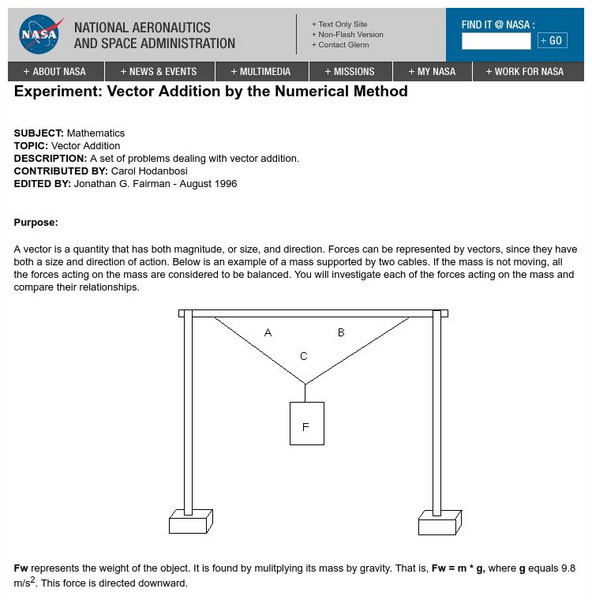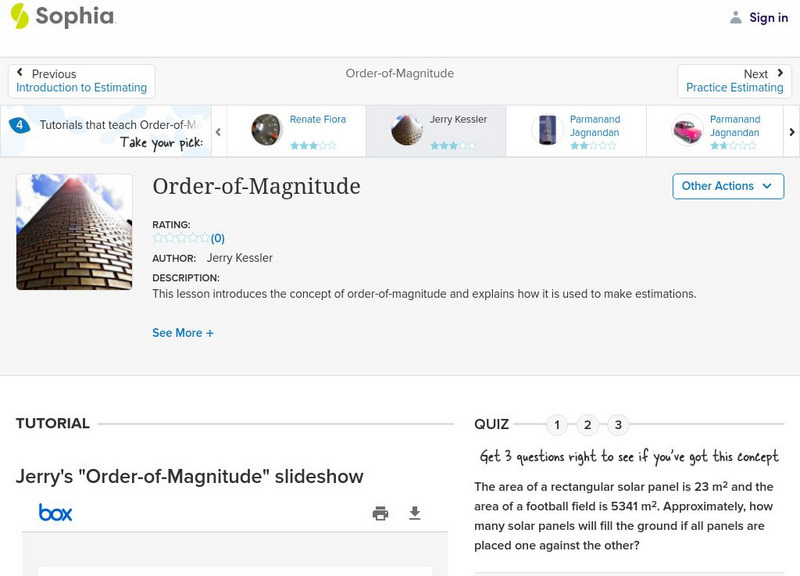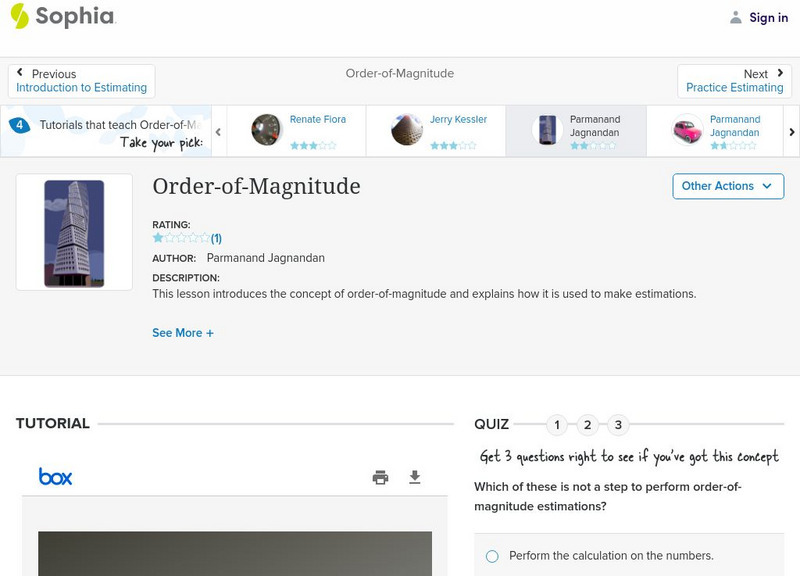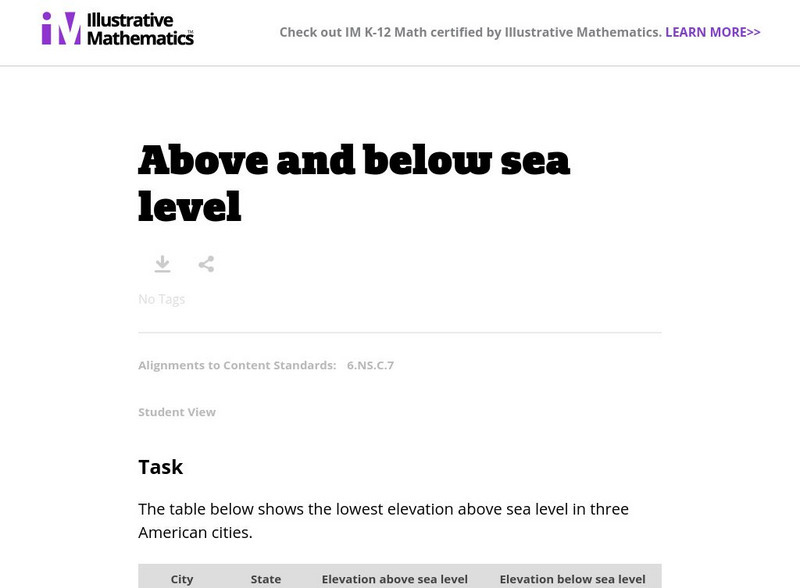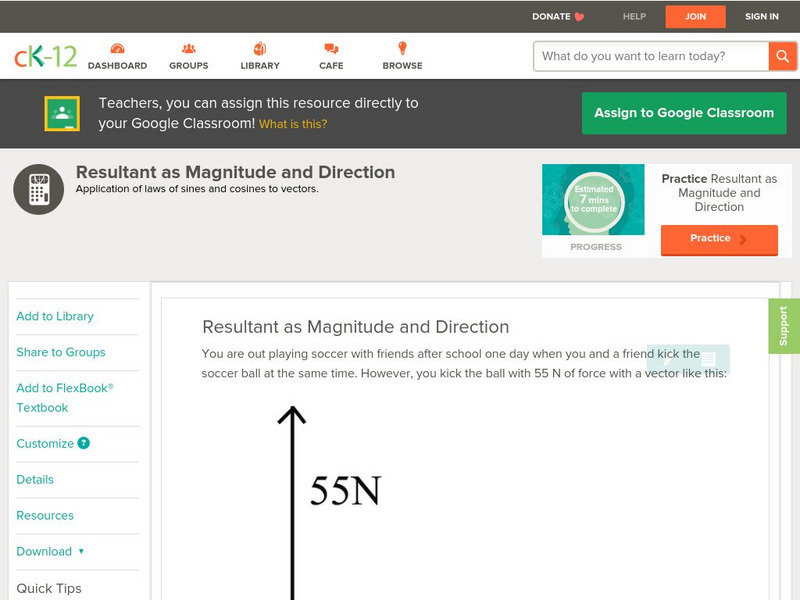University of Nebraska
University of Nebraska: Unit Vectors
In this resource unit vectors are defined and examples are given here. Notation is discussed also.
Science Education Resource Center at Carleton College
Serc: Understanding Vectors Vector Addition
By participating in a group activity, students will learn how to add force vectors. They will see the significance of direction when adding vector quantities.
Other
Ncedc: Make Your Own Seismogram
This site from NCEDC gives you an opportunity to "make your own seismogram" by choosing from a number of options on the screen.
Other
Scientific Visualization: Vector Calculation
A Java applet on vector addition. Users drag two or more vectors to be added together. Clicking a button shows the resultant of the vectors.
NASA
Nasa: Vector Addition by the Numerical Method
A lab experiment involving readily available materials. Students analyze three forces acting upon one point to determine the resultant force. Questions and accompanying answers are provided.
Other
University of Arkansas: Simple Machines
A thorough discussion of all the simple machines, beginning with some thoughts on mechanical advantage and conservation of energy. Very complete. Move down to the section that interests you.
NASA
Nasa: Imagine the Universe: How Big Is That Star
This 2-5 day lesson plan investigates the diameter, radius and mass among several stars in order to understand stellar behavior, particularly in a binary system.
Physics Classroom
The Physics Classroom: Kinetic Energy
Kinetic energy is defined and explained--learning exercises are included to assess your understanding.
Sophia Learning
Sophia: Distance & Displacement
A video tutorial and slide show lesson explains the similarities and differences between distance and displacement. [3:11]
Sophia Learning
Sophia: Order of Magnitude
This slide show presentation introduces the concept of order-of-magnitude, and how it is used to estimate large values in physics.
Sophia Learning
Sophia: Order of Magnitude
A short introduction to the concept of order-of-magnitude, with an explanation of how it is used to make estimations in physics.
Other
Algebra Lab: Word Lesson: Vectors Right Triangles Components and Resultants
Solve problems using vectors that involve velocity, speed, direction, and magnitude. Includes examples and practice problems. Click on the buttons under the practice questions to see the solutions.
Physics Classroom
The Physics Classroom: Newton's Laws: Drawing Free Body Diagrams
Students practice reading situations where forces are acting upon objects in all directions and magnitudes, and then draw free-body diagrams to represent the forces. Each problem has a self-checking key linked right on the page.
Physics Aviary
Physics Aviary: Resultant Vector
A program that will randomly generate three sequential motions. You must determine the resultant vector's magnitude and direction.
Physics Aviary
Physics Aviary: Practice Problems: Net Force Difficult
A random problem dealing with three random forces. Must find the net force of the three forces.
Physics Classroom
The Physics Classroom: Vectors & Projectiles: Vector Addition: Does Order Matter
Watch this short demonstration that focuses on a single question: Does the order in which vectors are added together affect the magnitude or the direction of the resultant?
Physics Classroom
The Physics Classroom: Motion and Forces in Two Dimensions: Vectors/direction
The emphasis of this unit is to understand some fundamentals about vectors, and to apply the fundamentals in order to understand motion and forces that occur in two dimensions.
Physics Classroom
The Physics Classroom: Vectors and Projectiles: Vector Direction
Through a short informational reading piece and an animated visual, students learn that vectors represent both magnitude and direction.
BBC
Bbc: Gcse Bitesize: Motion
This lesson focuses on motion including definitions, how to calculate the change in velocity and the average acceleration, and a link to an assessment.
Optical Society
Optical Society of America: Optics for Kids: Perspectives: Powers of 10
A drawing and measuring activity to give students an appreciation of magnitude in powers of ten, and of microscopes. Students draw themselves and an object life-size, and then examine smaller and smaller pieces of their picture.
Illustrative Mathematics
Illustrative Mathematics: 6.ns Above and Below Sea Level
The purpose of this task is to help students interpret signed numbers in a context as a magnitude and a direction and to make sense of the absolute value of a signed number as its magnitude. Aligns with 6.NS.C.7.
US Geological Survey
U.s. Geological Survey: What Causes Earthquakes?
USGS provides the definition of a fault, the basics of earthquakes, the theory of plate tectonics, location of plates and earthquakes, and embedded links to related material.
CK-12 Foundation
Ck 12: Vector Sum and Difference
[Free Registration/Login may be required to access all resource tools.] Looks at finding the direction and magnitude of vectors and breaking vectors into component parts.
CK-12 Foundation
Ck 12: Trigonometry: Resultant as Magnitude and Direction
[Free Registration/Login may be required to access all resource tools.] Express vectors in magnitude and direction form.






